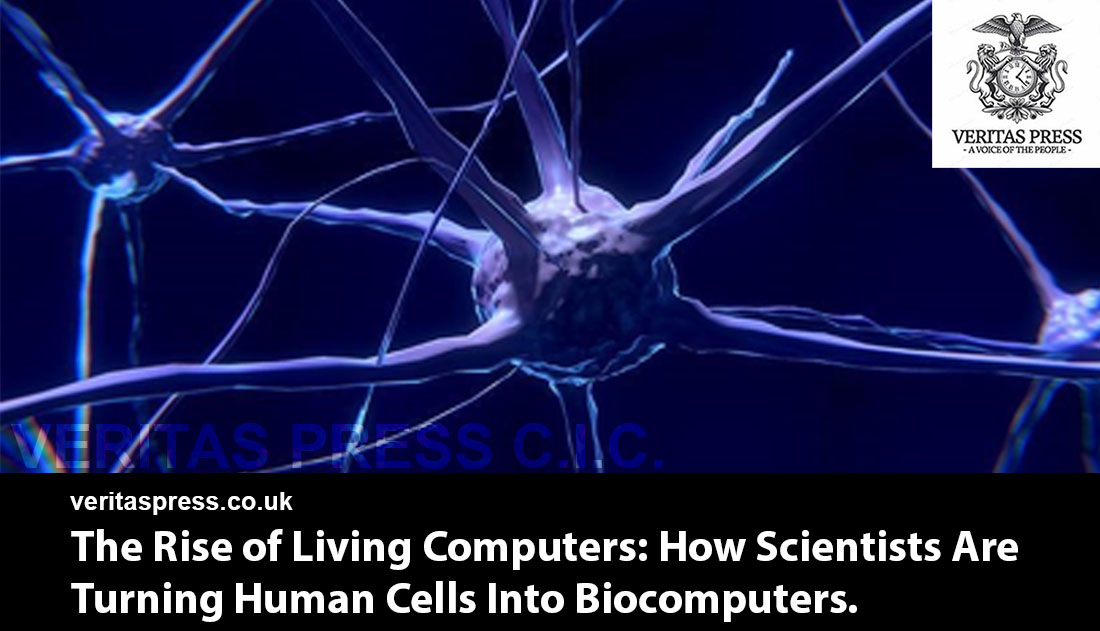
“Scientists are teaching human brain cells to compute, and it’s raising profound ethical questions.”
In a quiet laboratory in Switzerland, a team of researchers is training living human brain cells to think, turning biology itself into the next frontier of computing, an age of biocomputers.
The experiment, run by the Swiss startup FinalSpark, has built what they call the world’s first biocomputer, a device that uses clusters of living neurons to process data.
“We’re no longer just simulating neurons in silicon,” said FinalSpark co-founder Fred Jordan. “We are literally computing with life itself.”
Their system, dubbed the Neuroplatform, connects neurons through a microelectrode array that both stimulates and records their activity. The network learns to adapt its firing patterns in response to input, in other words, to compute.
According to FinalSpark, the device consumes about a million times less energy than a standard silicon chip performing similar functions.
A Living Answer To AI’s Energy Crisis:
The push toward biological computing comes amid mounting concern over AI’s massive carbon footprint.
Global data centres now consume up to 2% of the world’s electricity, a figure set to triple within a decade.
“Brains have had hundreds of millions of years of evolutionary optimisation,” said Dr. Lena Wu, a neuroscientist at Johns Hopkins University. “A single neuron can encode information in ways no transistor can replicate efficiently.”
Hopkins researchers are now leading the Organoid Intelligence Consortium, a coalition studying how brain organoids, miniature, self-organising neural tissues, could function as computing substrates. They call it a “third paradigm” of computing: combining biological adaptability with digital precision.
But even as the science advances, the ethical debate is catching up fast.
“Once neural organoids reach a certain level of connectivity and feedback, we face profound ethical questions,” warned Dr. Thomas Hartung, who heads the Hopkins project. “At what point does a system that learns also begin to feel?”
Oxford’s fluid-wall circuits and synthetic brains
Across the Atlantic, researchers at Oxford University are building the hardware that might one day make living computers reliable and scalable.
A team led by Prof. Ed Walsh and Dr. Richard Wade-Martins has received £2 million from the UK’s BBSRC to create fluid-wall microfluidic chambers, tiny environments where human neurons can grow into reproducible circuits linking brain regions like the midbrain, striatum and cortex.
“These models allow us to form controlled, reproducible neural pathways,” said Dr. Ricardo Marquez Gomez, a senior researcher on the project. “It’s an essential step toward stable living computational modules.”
Oxford scientists are also designing synthetic extracellular matrices, chemically defined hydrogels to replace animal-derived materials like Matrigel. By fine-tuning stiffness and pore size, they aim to standardise how neurons form 3D networks.
Such advances could eventually allow bio-processors to be mass-produced under consistent conditions, a necessary leap before living computing can move beyond the lab.
When Circuits Start To Sense:
The technology’s progress is prompting urgent philosophical reflection.
A 2025 paper in Oxford Open Neuroscience argued that the moral status of brain organoids depends not just on what they are made of, but on how they compute, specifically, whether information flows through feedback loops capable of generating awareness.
“An organoid’s architecture determines whether it can process feedback loops akin to consciousness,” wrote J. Lomax Boyd, a neuroscientist affiliated with Johns Hopkins and Oxford. “Once those loops exist, we must reconsider how we treat such entities, not merely as tools, but as proto-subjects.”
In The Edge of Sentience, an Oxford University Press volume, philosopher Jonathan Birch sounded a similar warning:
“Closed-loop organoids, particularly those interfacing with robotic or sensory systems, could cross moral thresholds faster than anticipated.”
Between Silicon And Flesh:
The emerging discipline of biocomputing now sits at a crossroads of neuroscience, computer engineering and ethics. For the moment, most living computers are simple, small neuron clusters trained to recognise sounds or navigate mazes. But each success pushes science closer to the creation of thinking tissue.
Some ethicists are calling for new governance models that treat advanced organoids less like lab material and more like research subjects.
“We may soon need a consent system for the cells we use,” said Dr. Emma Bianchi, a bioethicist advising the Hopkins consortium. “If an organoid can experience pain or preference, however primitive, research protocols must evolve.”
Oxford’s moral philosophers agree that society can no longer treat these systems as purely mechanical.
“The same traits that make organoid intelligence useful,” wrote Birch, “may also make it sentient.”
Computing With Life:
Despite the debate, the momentum is unstoppable.
FinalSpark has already made its Neuroplatform available online, allowing researchers around the world to run code on living neuron clusters via the cloud. Hopkins and Oxford teams are testing hybrid models that pair organic networks with AI systems, creating adaptive feedback loops that mimic learning.
Governments and funding bodies are taking notice: both the European Commission and the US National Science Foundation are drafting early guidelines for “wet computing” ethics and safety.
For FinalSpark’s Jordan, the implications are vast:
“Silicon is approaching its physical limits. The next frontier might not be quantum, it might be biological.”
Sources:
- BBC News, Scientists investigate how living cells could become biocomputers (Oct 2025)
- Nature, Organoid Intelligence: Computing with Living Brain Tissue (2025)
- Scientific American, The Promise and Peril of Living Computers (2025)
- Reuters, coverage of FinalSpark and EU “wet computing” regulations (2025)
- Johns Hopkins Organoid Intelligence Consortium, statements by Dr. Thomas Hartung & Dr. Lena Wu (2025)
- Oxford University Engineering Science, Creating brain circuits with human neurons and fluid walls (2025)
- Oxford Medical Sciences Division, Synthetic extracellular matrix for 3D human neural tissue (2025)
- Oxford Open Neuroscience, Moral Considerability of Brain Organoids from the Perspective of Computational Architecture, J. Lomax Boyd (2025)
- Oxford University Press, The Edge of Sentience, Jonathan Birch (2025)
Advertisements
Tags:



























